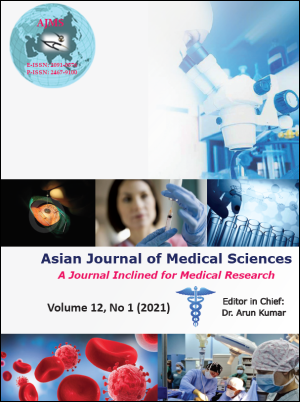Serum uric acid level as a marker of cardiovascular disease in diabetic individuals
Keywords:
Serum uric acid, Diabetes, Cardiovascular Disease, Lipid profileAbstract
Background: Serum Uric acid (SUA) had always been thought of as a metabolically inert end product of purine metabolism without physiological significance except gouty diathesis. However, it has been recently associated with insulin resistance and also considered as a risk marker for the development of diseases like diabetes, coronary heart disease.
Aims and Objective: In this study we aim to determine the incidence of hyperuricemia in diabetic individuals and also study the relation of SUA with the other established risk factor of cardiovascular diseases, as it is one of the long term complications of Diabetes.
Materials and Methods: The study enrolled 120 subjects. Group I (test group) comprised of 60 known cases of type II DM on oral anti-diabetic drugs. The control group comprised of 60 subjects who were non diabetic and not suffering from any major illness. The protocol of the study was approved by ethical committee of the institute. Total cholesterol, HDL, TG, glucose, SUA was estimated while parameters like LDL and VLDL were calculated.
Results: A highly significant increased SUA, total cholesterol, HDL, TG, glucose, LDL and VLDL was seen in type II DM (p<0.0001) when compared with control while a significant (p<0.05) positive correlation was observed between SUA and total cholesterol and TG. In study group a negative correlation though not statistically significant was observed between SUA and fasting blood sugar level.
Conclusion: SUA is definitely associated with development of complications of diabetes in the form of cardiovascular disease. This may be due to its influence on the deranged lipid metabolism and hyperglycemia.
Downloads
Downloads
Published
How to Cite
Issue
Section
License
Authors who publish with this journal agree to the following terms:
- The journal holds copyright and publishes the work under a Creative Commons CC-BY-NC license that permits use, distribution and reprduction in any medium, provided the original work is properly cited and is not used for commercial purposes. The journal should be recognised as the original publisher of this work.
- Authors are able to enter into separate, additional contractual arrangements for the non-exclusive distribution of the journal's published version of the work (e.g., post it to an institutional repository or publish it in a book), with an acknowledgement of its initial publication in this journal.
- Authors are permitted and encouraged to post their work online (e.g., in institutional repositories or on their website) prior to and during the submission process, as it can lead to productive exchanges, as well as earlier and greater citation of published work (See The Effect of Open Access).




